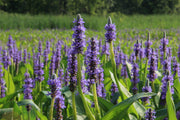
Table of Contents
You might raise an eyebrow at the inclusion of the word "weed" in the name of a plant recommended for your water garden, but don't let that deceive you. Pickerelweed (Pontederia cordata), otherwise known as pickerel rush, is anything but a nuisance. Quite the contrary, it is an exceptionally lovely and serviceable addition to any water garden, providing both beauty and ecology. Pickerelweed plants add a splash of color and dynamism with brilliant flower spikes to ponds, bogs, and rain garden edges and are incredibly low maintenance.
Aesthetic Appeal and Colorful Blooms
One of the primary reasons to incorporate pickerelweed into your water garden is its undeniable beauty. Depending on the variety, this plant will bear attractive flower spikes in bluish-purple, pink, or white. These dainty blooms rise above the sturdy, upright stems and will last from early summer well into fall. The glossy, arrow-shaped leaves are equally captivating and provide a lush, vibrant presence in any pond or water garden setting.
In addition to its ornamental value, pickerelweed plants can grow up to three feet tall and serve as a fine architectural backdrop to shorter plants like marsh marigold. Its tall, thin shape complements other water plants, adding texture and depth to the landscape of your garden.
Attracting Wildlife and Enhancing Biodiversity
Pickerelweed is not just a pretty face in the water garden—it's a real wildlife magnet. Its sweet nectar invites pollinators such as butterflies and bees, making it an indispensable plant for supporting local biodiversity. But that’s not all: dragonflies and damselflies often lay their eggs on pickerelweed plant stems, further contributing to the delicate ecosystem of your pond.
The wide, arrow-shaped leaves of pickerelweed also provide excellent cover for fish, giving them a place to hide from predators and rest. This natural habitat plays a key role in promoting the health and vibrancy of your pond’s ecosystem.
Easy to Grow and Maintain
Pickerelweed plants are incredibly low-maintenance, making them ideal for busy gardeners or those looking to simplify pond upkeep. This hardy plant thrives in full sun to partial shade and can tolerate a wide range of growing conditions, from zones 3 to 10.
Although pickerelweed requires little care, it does tend to spread quickly. To control its growth, it’s best to plant pickerelweed in an aquatic pot. This will help manage its size and prevent it from taking over your pond. Pruning faded flowers or bent stems is an easy way to keep your pickerel rush looking its best while controlling its growth.
Planting and Growing Tips
Planting pickerelweed is simple, and the best time to do it is in early spring. Here’s a quick guide to help you get started:
- Choose a Location: Pickerelweed thrives at the margins of ponds, bogs, or rain gardens. It requires full sun to partial shade and should be planted in about three to five inches of water.
- Use a Fabric Aquatic Planter: Place your pickerelweed in a fabric aquatic planter to control its growth. Fill the planter with pond potting media and add gravel on top to keep the soil from floating away.
- Fertilize as Needed: Add an aquatic plant fertilizer according to the package instructions to ensure your pickerelweed grows strong and healthy.
- Place in the Pond: Lower the planter into the pond, positioning it near the edge so that the crown of the plant is just above the water’s surface.
With proper care, your pickerelweed should start blooming in June and continue to flower through October, adding bright color and natural beauty to your pond.
Conclusion
Whether you're looking to enhance the beauty of your water garden, attract more wildlife, or simply maintain a healthier pond, pickerelweed is one of the best additions you can make. With its bright flowers, low maintenance needs, and contributions to your pond’s ecosystem, this plant will give much more than it takes. Pickerelweed adds a beautiful, balanced touch to your pond and creates an environment that will thrive for years to come.







